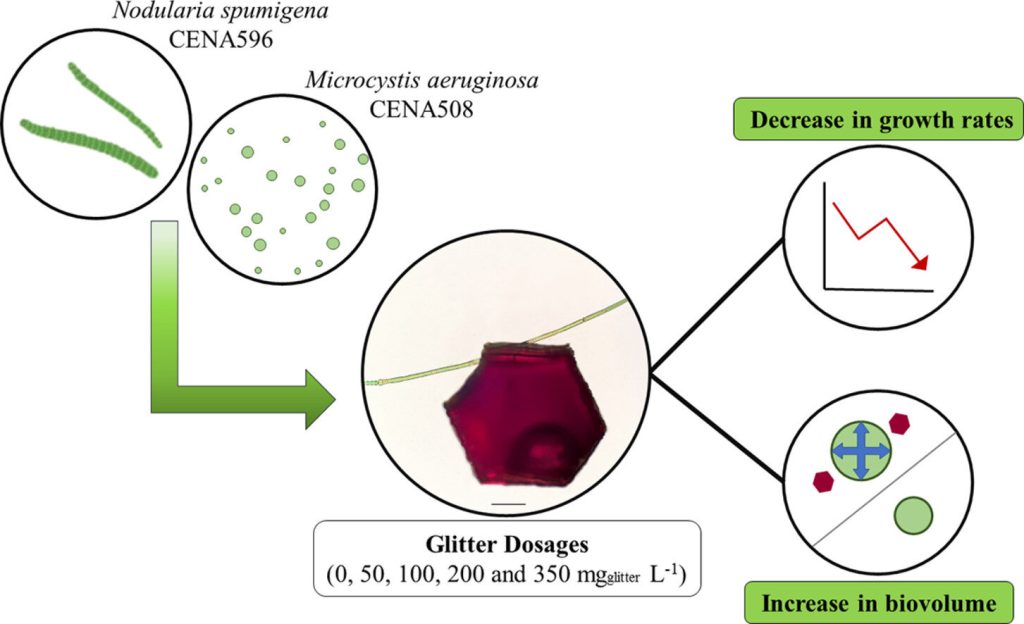Credit: Aquatic Toxicology (2023). DOI: 10.1016/j.aquatox.2023.106590
A study conducted by researchers affiliated with the University of São Paulo (USP) in Brazil has concluded that particles of glitter can hinder the growth of organisms at the base of aquatic ecosystems, such as cyanobacteria (blue-green algae), which play a key role in the biogeochemical cycles of water and soil, as well as being eaten by other organisms. An article on the study is published in the journal Aquatic Toxicology.
Ubiquitous in makeup, nail polish, holiday decorations, greeting cards, Carnival costumes and many other places, glitter sticks to skin and clothes and requires a lot of effort to remove. It is made up of microplastics, tiny particles under 5 mm in size, typically polyethylene terephthalate (PET) or polyvinyl chloride (PVC), coated with aluminum to create a reflective surface.
Microplastics are too small to be filtered out by wastewater treatment plants and end up flowing from drains in shower stalls or sinks to rivers, beaches and oceans. More than 8 million metric tons of glitter are estimated to have been discharged into the ocean in recent years, according to recent scientific studies.
Glitter is not biodegradable and harms aquatic organisms along with the entire surrounding ecosystem via ingestion, contact with toxic ingredients, and injury caused by its sharp edges. In addition, the shape, size and physicochemical properties of the microparticles in glitter hinder accurate measurement of water contamination levels.
The researchers analyzed the effects of five concentrations of glitter particles on two bloom-forming cyanobacteria strains, Microcystis aeruginosa CENA508 (unicellular) and Nodularia spumigena CENA596 (filamentous). Both are part of a collection of almost 800 strains assembled in Brazil by the Cyanos group. The scientists measured their cellular growth rates every three days for 21 days by spectrophotometry, estimating the intensity of light spectra absorbed and transmitted by each sample based on the number of photons emitted.
“We found that increasing the amount of glitter raised the biovolume of the cyanobacterial cells and boosted stress to levels that even impaired photosynthesis. The toxicity of glitter for microorganisms has hardly been studied at all. Whatever affects cyanobacteria will indirectly affect other organisms in the same environment,” said Mauricio Junior Machado, first author of the article and a researcher in CENA-USP’s Cellular and Molecular Biology Laboratory.
The results suggest that environmental levels of glitter similar to the highest level tested—350 milligrams per liter of water (mg/L)—can negatively influence susceptible organisms in aquatic ecosystems. The most evident effect was seen in M. aeruginosa, whose growth rate was best at 50 mg/L and worst at 200 mg/L. In the case of N. spumigena, the range was 100-137 mg/L, above which cell density was irrecoverably damaged. The difference in growth rates occurred only on the twenty-first day of the experiment.
Chlorophyll and carotenoids did not vary significantly, but in absolute terms, both strains displayed a fall in carotenoids when exposed to glitter at 200 mg/L and 350 mg/L, and chlorophyll fluorescence varied in N. spumigena when exposed to glitter at 350 mg/L.
Consumer education
The authors hope the study will help educate consumers and policymakers about the importance of avoiding pollution by microplastics. “Glitter is sold for use in festivities, where people spare little thought for the environmental problems it causes,” noted Marli de Fátima Fiore, last author of the article. “However, it’s necessary to bear in mind that microplastics contaminate and damage marine and freshwater ecosystems, which are extremely important to our lives, and to think about campaigns to avoid microplastic pollution as much as possible.”
The researchers now plan to perform the same tests on other cyanobacterial strains, as well as analyze so-called biodegradable glitter to find out whether it causes problems such as metallic components and pigments harming organisms.
More information: Mauricio J. Machado et al, Response of two cyanobacterial strains to non-biodegradable glitter particles, Aquatic Toxicology (2023). DOI: 10.1016/j.aquatox.2023.106590
Citation: Glitter impairs growth of organisms with key roles in aquatic ecosystems, study shows (2023, August 22) retrieved 20 September 2023 from https://phys.org/news/2023-08-glitter-impairs-growth-key-roles.html
This document is subject to copyright. Apart from any fair dealing for the purpose of private study or research, no part may be reproduced without the written permission. The content is provided for information purposes only.

